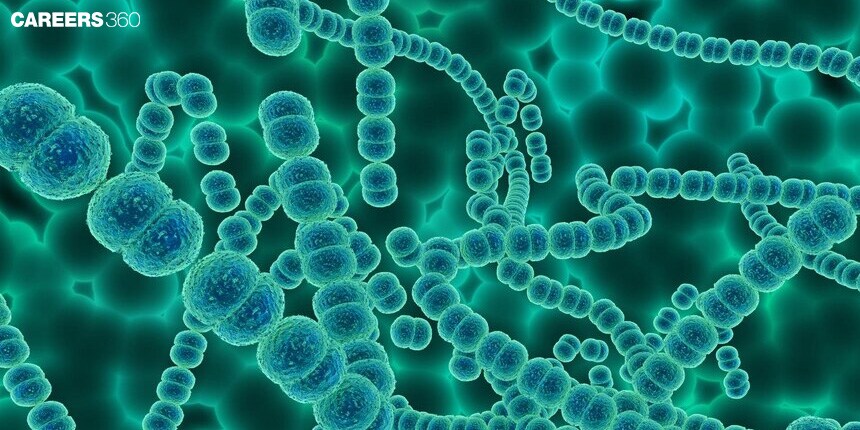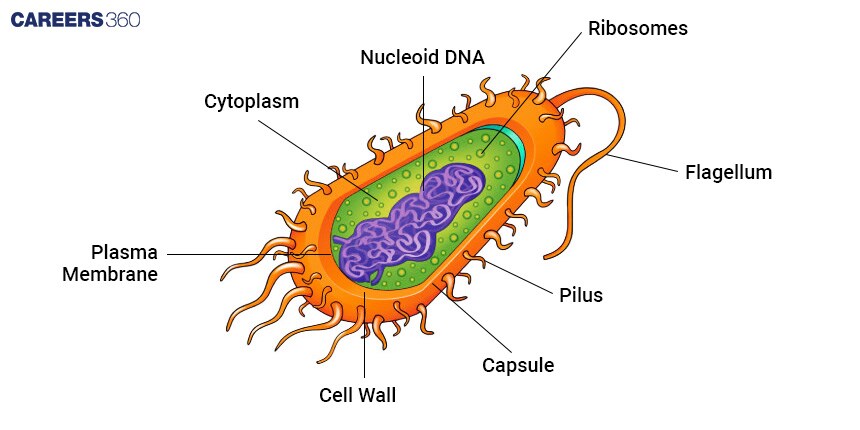Archaebacteria - Definition, Characteristics, Types, Examples, Importance
Archaebacteria definition: Archaebacteria are found in extreme environments such as hot springs, salt lakes, and deep-sea vents. It is a unique group of microorganisms, which is different from bacteria and eukaryotes. About Archaebacteria, they play an important role in ecological processes, including methane production and nutrient cycling. Archaebacteria is a topic of the chapter Biological Classification in Biology.
NEET 2025: Mock Test Series | Syllabus | High Scoring Topics | PYQs
NEET Important PYQ's Subject wise: Physics | Chemistry | Biology
New: Meet Careers360 B.Tech/NEET Experts in your City | Book your Seat now
- What is Archaebacteria?
- Classification of Archaebacteria
- Evolutionary Relationships of Archaebacteria
- Archaebacteria Characteristics
- Habitats of Archaebacteria
- Reproduction and Growth in Archaebacteria
- Ecological and Biotechnological Significance
- Recommended Video on Archaebacteria

What is Archaebacteria?
Archaebacteria form a domain of single-celled microorganisms that have emerged and developed differently from bacteria and eukaryotes. Due to the peculiarity of cell-membrane lipids and unique genetic sequences not found anywhere else in any form of life, these microbes can dwell and survive under conditions that are mostly unbearable to all other forms of life. This means that they exist in particular extreme environments like hot springs, salt lakes, and deep-sea hydrothermal vents.
Archaebacteria were discovered through the work of Carl Woese and George Fox on the ribosomal RNA in the 1970s. They indicated that these microbes were of importance not only in biogeochemical cycles but also in biotechnology applications. Their unique metabolic pathways and consequently their resilience have now become a focus in research in terms of both their importance in evolutionary biology as well as industrial processes.
Classification of Archaebacteria
These organisms are classified into the following types:
Euryarchaeota
Methanogens: These microbes generate methane as a metabolic byproduct under anoxic conditions.
Halophiles: can survive in high-salt, salt-laden antibiotic-resistant organisms as in the case of salt lakes.
Thermophiles: Live in extremely hot environments like hydrothermal vents.
Crenarchaeota
Hyperthermophiles: Optimum growth at extremely high temperatures; usually above 80°C.
Acidophiles: Survive highly acidic environments, for instance in sulfuric springs.
Established in a variety of environments, both in the sea and in soils.
Thaumarchaeota
Mesophiles: Its natural habitat should be at a middle range of temperature, unlike several other archaea.
Ammonia-oxidising: Its role is to oxidise ammonia to nitrite in the nitrogen cycle.
These are widespread in marine and soil environments.
Nanoarchaeota
Very tiny archaea that exist in symbiosis with other archaea.
Known from hydrothermal vent areas.
Example-Nanoarchaeum equitans was attached to the host Ignicoccus.
Korarchaeota
Known from DNA sequences found in high-temperature environments.
It is considered to represent an ancient lineage of archaea.
Rarely occur as isolates; very little information is available concerning aspects of their biology.
Also read-
Evolutionary Relationships of Archaebacteria
Archaebacteria are one of the three domains of life, separate from Bacteria and Eukarya.
Phylogenetic analyses of the sequences of several ribosomal RNAs relate the archaea more closely with the eukaryotes than with the bacteria.
The diversity corresponded to archaes that held ancient origins but were extremely habitual in their habitat.
Archaebacteria Characteristics
The characteristics of the archaebacteria are defined as:
Cell Structure
Absence of peptidoglycan It is found in bacterial cell walls.
It contains unique polysaccharides and proteins.
Ether-linked lipids rather than ester-linked as in bacteria and eukaryotes.
However, sometimes branched isoprenoid chains also form monolayers and provide stability under extreme conditions.
Genetic Material
It has circular DNA like bacteria but with unique sequences.
Histone-like proteins associated with DNA.
Its RNA polymerase and ribosomes are more similar to eukaryotic than to bacterial RNA polymerase and ribosomes.
Metabolic Pathways
Use of unique enzymes and cofactors.
Capable of methanogenesis, a process not found in bacteria or eukaryotes.
Ability to metabolise a variety of compounds, including sulfur and ammonia.
Archaebacteria Diagram
The diagram below shows the cell of archaebacteria and its components.

Archaebacteria Types
The various types of archaebacteria are-
Methanogens
These are archaebacteria found in marshy areas.
These uses of archaebacteria include decomposition of carbon dioxide and formic acid into methane.
E.g. Methanobacterium, Methanococcus etc.
Halophiles
These archaebacteria are found in salty areas.
They can live in high salt conditions because of the presence of special lipids in their membranes, the presence of mucilage covering, the absence of sap vacuole and high internal salt content.
E.g. Halobacterium, Halococcus.
Thermoacidophiles
These archaebacteria can tolerate high temperatures and high acid conditions.
Thermoacidophiles contain enzymes that can operate at high temperatures.
E.g. Thermoplasma, Thermoproteus.
Habitats of Archaebacteria
The archaebacteria are well known for their ability to exist in some of the most extreme environments on Earth, such as taking temperatures greater than 100°C, hypersaline salt lakes with salinities well above that of seawater and highly acidic springs with pH levels less than 3. In addition to these extremes, archaebacteria exist in more benign environments such as soils, where they participate in nutrient cycling and oceans, where they are thought to play an important role in marine ecosystems. They have adapted to the most diverse and generally hostile conditions, which is as much testimony to the remarkable ecological resilience as to their importance.
Reproduction and Growth in Archaebacteria
Archaebacteria mainly use asexual means to reproduce. The most common means is that of binary fission in which one cell simply divides into two identical daughter cells. Some archaebacteria will reproduce via budding, growing a new organism attached to but off the body of the parent, or by fragmentation, where the parent simply breaks apart into pieces with each piece, or fragment thereof, able to grow into a new organism. Because their means to reproduce are so effective, archaebacteria can colonise extreme environments quickly.
Several environmental factors act as the main determinants of archaebacteria's growth. They thrive in a range of temperatures from hyperthermophiles that live in extremely hot habitats to psychrophiles that dwell in cold. pH is another key aspect of their optimum growth and survival. Acidophiles are found in highly acidic habitats while alkaliphiles thrive in totally basic ones. Finally, salinity acts as an equally important determinant where halophiles require high salt concentration. The most striking fact about the growth conditions of archaebacteria is their versatility and adaptability.
Ecological and Biotechnological Significance
Archaebacteria have an application in either ecosystems or biotechnology. Ecologically, they are key players in biogeochemical cycles, such as the carbon cycle and nitrogen cycle, in which they act as mediators to produce methane and oxidize ammonia. They also form symbiosis with a wide array of organisms that increase nutrient exchange and environmental adaptability. Biotechnologically, they have great use in giving methods of producing industrial enzymes that could work under extreme conditions. They can be used to produce biofuels through the production of methane, and in bioremediation, they can clean pollutants in hostile environments.
Also Read-
| Cell Envelope | Five Kingdom Classification |
| Composition of Bacterial Cell Wall | Kingdom Monera, Protista And Fungi |
| Gram Staining | Salient features of the Kingdom Monera |
Recommended Video on Archaebacteria
Frequently Asked Questions (FAQs)
The archaebacteria are a kind of microorganism very similar to bacteria, except for the fact that their genetic makeup is very different; these organisms are usually extremophiles
The composition of the cell wall, its membrane lipids, and the genetic material are such that the archaebacteria can exist in extreme conditions where eubacteria cannot exist.
They occur in extreme environments like hydrothermal vents where water comes out somewhat like a volcano eruption, salt lakes, and acidic springs but also occur in more moderate habitats like soil and oceans.
Due to their stability and efficiency under conditions of extreme variability, applications of archaebacteria have been found in industrial enzyme production, biofuel production, and bioremediation.
Their roles in various biogeochemical cycles, carbon, and nitrogen cycles are very important; they also form symbiotic relationships with other organisms and hence help in nutrient cycling along with energy flow in the ecosystem.
Also Read
30 Nov'24 12:23 PM
28 Nov'24 05:34 PM
25 Nov'24 05:18 PM
23 Nov'24 10:02 AM
22 Nov'24 01:59 PM
21 Nov'24 04:58 PM
16 Nov'24 01:58 PM